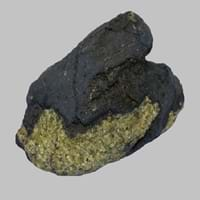Definition
Marl is an unconsolidated sedimentary rock consisting of clay and lime
Basanite is a black basaltic rock which mainly contains plagioclase, augite, olivine and nepheline and is formerly used as a touchstone
Discoverer
Unknown
Unknown
Etymology
From Old French marle, from Late Latin marglia
From Latin basanites + -ite
Class
Sedimentary Rocks
Igneous Rocks
Sub-Class
Durable Rock, Soft Rock
Durable Rock, Hard Rock
Group
Not Applicable
Not Applicable
Other Categories
Fine Grained Rock, Opaque Rock
Fine Grained Rock, Opaque Rock
Texture
Earthy
Aphanitic to Porphyritic
Color
Beige, Brown, Green, Grey, White
Black, Brown, Green, Grey, Red, White
Durability
Durable
Durable
Appearance
Rough and Dull
Glassy or Pearly
Interior Uses
Decorative Aggregates, Floor Tiles
Decorative Aggregates, Homes
Exterior Uses
As Building Stone, Roof Tiles
As Building Stone, Garden Decoration, Office Buildings
Other Architectural Uses
Curbing
Whetstones
Construction Industry
Cement Manufacture, Construction Aggregate, for Road Aggregate, Making natural cement, Raw material for the manufacture of mortar
Arrowheads, Construction Aggregate, Cutting Tool, Spear Points
Medical Industry
Not Yet Used
Not Yet Used
Antiquity Uses
Artifacts, Jewellery, Sculpture, Small Figurines
Artifacts, Monuments
Commercial Uses
Creating Artwork, Soil Conditioner
As a touchstone, Creating Artwork, Gemstone, In fire-starting tools, Manufacture of tools, Metallurgical Flux, Jewelry, To ignite fire, Used in flintlock firearms
Types
Clay Marl ,Blue Marl, Red Marl, High Bank Marl, Shell Layer Marl, Under Shell Layer Marl, Sand Marl, Green Marl, Grey Marl and Clayey Marl
Nepheline-Basanite, Analcite-Basanite and Leucite-Basanite
Features
Generally rough to touch, Is one of the oldest rock, Splintery, Very fine grained rock
Clasts are smooth to touch, Easily splits into thin plates, Has High structural resistance against erosion and climate, Used as a touchstone
Archaeological Significance
Monuments
Not Yet Used
Used
Famous Monuments
Not Applicable
Data Not Available
Sculpture
Used
Not Yet Used
Famous Sculptures
Data Not Available
Not Applicable
Pictographs
Used
Not Used
Petroglyphs
Used
Not Used
Figurines
Used
Not Yet Used
Formation
Marl forms when very fine-grained clay particles are deposited in water which settles at the bottom of water bodies and are compacted by overlying sediment; the water squeezes out and hence forming Marl rock.
Basanite is a fine-grained, hard rock that forms when bits of lava shoot out of volcanoes.
Mineral Content
Calcite, Clay, Dolomite, Gypsum, Micas, Pyrite, Quartz
Augite, Feldspar, Ilmenite, Olivine, Plagioclase
Compound Content
Aluminium Oxide, NaCl, CaO, Iron(III) Oxide, Silicon Dioxide
Potassium Oxide, Sodium Oxide, Silicon Dioxide
Types of Metamorphism
Not Applicable
Burial Metamorphism, Cataclastic Metamorphism, Contact Metamorphism, Regional Metamorphism
Types of Weathering
Biological Weathering, Chemical Weathering
Chemical Weathering, Mechanical Weathering
Types of Erosion
Chemical Erosion, Coastal Erosion, Water Erosion, Wind Erosion
Chemical Erosion, Coastal Erosion, Glacier Erosion, Sea Erosion, Water Erosion, Wind Erosion
Grain Size
Very fine-grained
Fine Grained
Fracture
Conchoidal
Uneven, Splintery or Conchoidal
Porosity
Highly Porous
Highly Porous
Luster
Dull
Waxy and Dull
Cleavage
Not Available
Non-Existent
Specific Gravity
2.2-2.8
2.5-2.8
Transparency
Opaque
Translucent to Opaque
Density
2.4-2.8 g/cm3
2.7 g/cm3
Specific Heat Capacity
Not Available
Resistance
Heat Resistant, Impact Resistant
Heat Resistant, Impact Resistant, Pressure Resistant, Wear Resistant
Deposits in Eastern Continents
Asia
India, Pakistan, Russia
Not Yet Found
Africa
Ethiopia, Kenya, Morocco, South Africa
Uganda
Europe
Austria, France, Germany, Greece, Italy, Romania, Scotland, Spain, Switzerland
Germany, Hungary, Italy, Spain
Others
Not Yet Found
Greenland, Mid-Atlantic Ridge
Deposits in Western Continents
South America
Colombia, Ecuador, Peru
Bolivia, Brazil
Deposits in Oceania Continent
Australia
New South Wales, Victoria, Western Australia
New South Wales, New Zealand, Queensland, South Australia, Western Australia
All about Marl and Basanite Properties
Know all about Marl and Basanite properties here. All properties of rocks are important as they define the type of rock and its application. Marl belongs to Sedimentary Rocks while Basanite belongs to Igneous Rocks.Texture of Marl is Earthy whereas that of Basanite is Aphanitic to Porphyritic. Marl appears Rough and Dull and Basanite appears Glassy or Pearly. The luster of Marl is dull while that of Basanite is waxy and dull. Marl is available in beige, brown, green, grey, white colors whereas Basanite is available in black, brown, green, grey, red, white colors. The commercial uses of Marl are creating artwork, soil conditioner and that of Basanite are as a touchstone, creating artwork, gemstone, in fire-starting tools, manufacture of tools, metallurgical flux, jewelry, to ignite fire, used in flintlock firearms.










